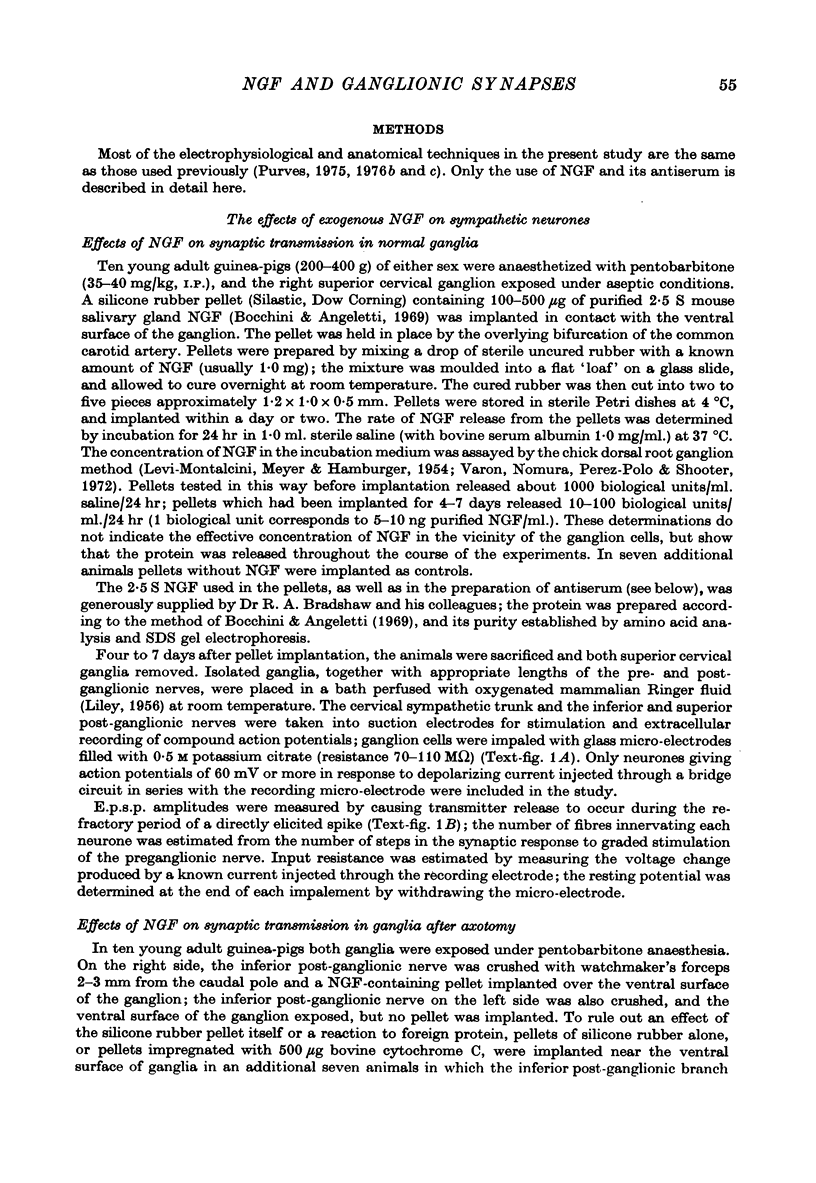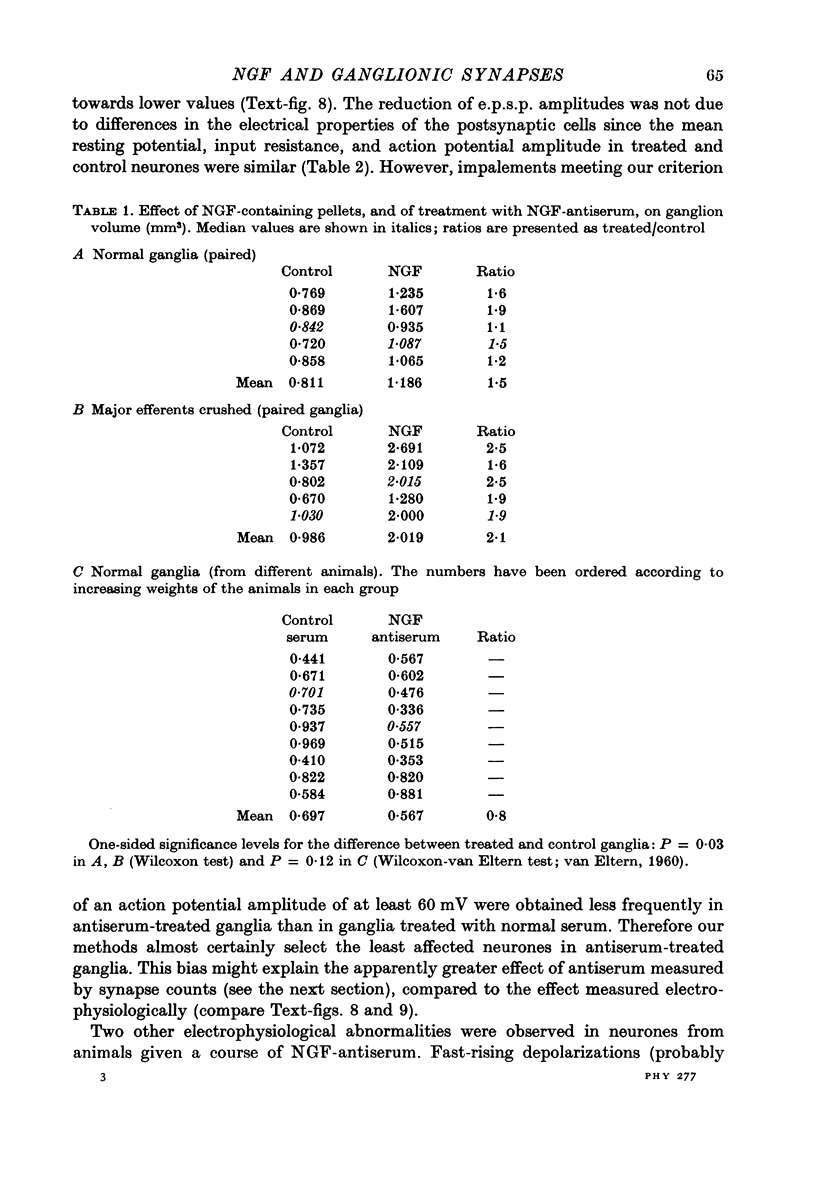Abstract
1. The effects of nerve growth factor (NGF) and its antiserum on synapses in the superior cervical ganglion of the guinea-pig have been examined by intracellular recording and electron microscopy. 2. Exogenous NGF, supplied locally from a silicone rubber pellet implanted near ganglia for 4-7 days, had little effect on either the function or the number of ganglionic synapses. 3. However, the depression of synaptic transmission and loss of synaptic contacts on ganglion cells which follow post-ganglionic axotomy were diminished by about 50% in the presence of exogenous NGF. 4. Other post-axotomy changes such as the development of subthreshold regenerative responses in neuronal processes, the appearance of ultrastructurally abnormal neuronal profiles suggesting rapid membrane turnover, and the cytoplasmic and nuclear changes characteristic of "chromatolysis", were also largely prevented by exogenous NGF. 5. Systemic treatment of neonatal and young adult guinea-pigs with antiserum to NGF for 4-5 days caused depression of intracellularly recorded synaptic responses within 5-8 days of the end of antiserum administration. Synapse counts in electron microscopical sections from these ganglia showed only about half as many contacts as in control ganglia from animals receiving normal rabbit serum. 6. These findings suggest that the loss of synapses from sympathetic neurones which follows axotomy results from a reduction in the amount of NGF supplied to ganglion cells. A corollary is that, among other biological roles, NGF is required by peripheral sympathetic neurones to maintain the synapses they receive.
Full text
PDF























Images in this article
Selected References
These references are in PubMed. This may not be the complete list of references from this article.
- Aguayo A. J., Peyronnard J. M., Terry L. C., Romine J. S., Bray G. M. Neonatal neuronal loss in rat superior cervical ganglia: retrograde effects on developing preganglionic axons and Schwann cells. J Neurocytol. 1976 Apr;5(2):137–155. doi: 10.1007/BF01181653. [DOI] [PubMed] [Google Scholar]
- Aloe L., Mugnaini E., Levi-Montalcini R. Light and electron microscopic studies on the excessive growth of sympathetic ganglia in rats injected daily from birth with 6-OHDA and NGF. Arch Ital Biol. 1975 Dec;113(4):326–353. [PubMed] [Google Scholar]
- Angeletti P. U., Levi-Montalcini R., Caramia F. Analysis of the effects of the antiserum to the nerve growth factor in adult mice. Brain Res. 1971 Apr 2;27(2):343–355. doi: 10.1016/0006-8993(71)90259-9. [DOI] [PubMed] [Google Scholar]
- Angeletti P. U., Levi-Montalcini R., Caramia F. Ultrastructural changes in sympathetic neurons of newborn and adult mice treated with nerve growth factor. J Ultrastruct Res. 1971 Jul;36(1):24–36. doi: 10.1016/s0022-5320(71)80086-2. [DOI] [PubMed] [Google Scholar]
- Angeletti R. H., Aneletti P. U., Levi-Montalcini R. Selective accumulation of ( 125 I) labelled nerve growth factor in sympathetic ganglia. Brain Res. 1972 Nov 13;46:421–425. doi: 10.1016/0006-8993(72)90033-9. [DOI] [PubMed] [Google Scholar]
- Bjerre B., Wiklund L., Edwards D. C. A study of the de- and regenerative changes in the sympathetic nervous system of the adult mouse after treatment with the antiserum to nerve growth factor. Brain Res. 1975 Jul 11;92(2):257–278. doi: 10.1016/0006-8993(75)90274-7. [DOI] [PubMed] [Google Scholar]
- Black I. B., Hendry I. A., Iversen L. L. The role of post-synaptic neurones in the biochemical maturation of presynaptic cholinergic nerve terminals in a mouse sympathetic ganglion. J Physiol. 1972 Feb;221(1):149–159. doi: 10.1113/jphysiol.1972.sp009745. [DOI] [PMC free article] [PubMed] [Google Scholar]
- Bocchini V., Angeletti P. U. The nerve growth factor: purification as a 30,000-molecular-weight protein. Proc Natl Acad Sci U S A. 1969 Oct;64(2):787–794. doi: 10.1073/pnas.64.2.787. [DOI] [PMC free article] [PubMed] [Google Scholar]
- Brenner H. R., Johnson E. W. Physiological and morphological effects of post-ganglionic axotomy on presynaptic nerve terminals. J Physiol. 1976 Aug;260(1):143–158. doi: 10.1113/jphysiol.1976.sp011508. [DOI] [PMC free article] [PubMed] [Google Scholar]
- Brenner H. R., Martin A. R. Reduction in acetylcholine sensitivity of axotomized ciliary ganglion cells. J Physiol. 1976 Aug;260(1):159–175. doi: 10.1113/jphysiol.1976.sp011509. [DOI] [PMC free article] [PubMed] [Google Scholar]
- Brown M. C., Jansen J. K., Van Essen D. Polyneuronal innervation of skeletal muscle in new-born rats and its elimination during maturation. J Physiol. 1976 Oct;261(2):387–422. doi: 10.1113/jphysiol.1976.sp011565. [DOI] [PMC free article] [PubMed] [Google Scholar]
- Cohen S., Levi-Montalcini R., Hamburger V. A NERVE GROWTH-STIMULATING FACTOR ISOLATED FROM SARCOM AS 37 AND 180. Proc Natl Acad Sci U S A. 1954 Oct;40(10):1014–1018. doi: 10.1073/pnas.40.10.1014. [DOI] [PMC free article] [PubMed] [Google Scholar]
- Cowan W. M., Wann D. F. A computer system for the measurement of cell and nuclear sizes. J Microsc. 1973 Dec;99(3):331–348. doi: 10.1111/j.1365-2818.1973.tb04630.x. [DOI] [PubMed] [Google Scholar]
- Cull R. E. Rôle of axonal transport in maintaining central synaptic connections. Exp Brain Res. 1975 Nov 28;24(1):97–101. doi: 10.1007/BF00236020. [DOI] [PubMed] [Google Scholar]
- EBBESSON S. O. A QUANTITATIVE STUDY OF HUMAN SUPERIOR CERVICAL SYMPATHETIC GANGLIA. Anat Rec. 1963 Aug;146:353–356. doi: 10.1002/ar.1091460408. [DOI] [PubMed] [Google Scholar]
- Hamburger V. Changing concepts in developmental neurobiology. Perspect Biol Med. 1975 Winter;18(2):162–178. doi: 10.1353/pbm.1975.0002. [DOI] [PubMed] [Google Scholar]
- Hendry I. A., Campbell J. Morphometric analysis of rat superior cervical ganglion after axotomy and nerve growth factor treatment. J Neurocytol. 1976 Jun;5(3):351–360. doi: 10.1007/BF01175120. [DOI] [PubMed] [Google Scholar]
- Hendry I. A., Stöckel K., Thoenen H., Iversen L. L. The retrograde axonal transport of nerve growth factor. Brain Res. 1974 Mar 15;68(1):103–121. doi: 10.1016/0006-8993(74)90536-8. [DOI] [PubMed] [Google Scholar]
- Hendry I. A. The response of adrenergic neurones to axotomy and nerve growth factor. Brain Res. 1975 Aug 22;94(1):87–97. doi: 10.1016/0006-8993(75)90879-3. [DOI] [PubMed] [Google Scholar]
- Hendry I. A. The retrograde trans-synaptic control of the development of cholinergic terminals in sympathetic ganglia. Brain Res. 1975 Mar 28;86(3):483–487. doi: 10.1016/0006-8993(75)90900-2. [DOI] [PubMed] [Google Scholar]
- LEVI-MONTALCINI R., MEYER H., HAMBURGER V. In vitro experiments on the effects of mouse sarcomas 180 and 37 on the spinal and sympathetic ganglia of the chick embryo. Cancer Res. 1954 Jan;14(1):49–57. [PubMed] [Google Scholar]
- LILEY A. W. An investigation of spontaneous activity at the neuromuscular junction of the rat. J Physiol. 1956 Jun 28;132(3):650–666. doi: 10.1113/jphysiol.1956.sp005555. [DOI] [PMC free article] [PubMed] [Google Scholar]
- Landmesser L., Pilar G. Fate of ganglionic synapses and ganglion cell axons during normal and induced cell death. J Cell Biol. 1976 Feb;68(2):357–374. doi: 10.1083/jcb.68.2.357. [DOI] [PMC free article] [PubMed] [Google Scholar]
- Levi-Montalcini R., Aloe L., Mugnaini E., Oesch F., Thoenen H. Nerve growth factor induces volume increase and enhances tyrosine hydroxylase synthesis in chemically axotomized sympathetic ganglia of newborn rats. Proc Natl Acad Sci U S A. 1975 Feb;72(2):595–599. doi: 10.1073/pnas.72.2.595. [DOI] [PMC free article] [PubMed] [Google Scholar]
- Levi-Montalcini R., Angeletti P. U. Nerve growth factor. Physiol Rev. 1968 Jul;48(3):534–569. doi: 10.1152/physrev.1968.48.3.534. [DOI] [PubMed] [Google Scholar]
- Levi-Montalcini R., Booker B. EXCESSIVE GROWTH OF THE SYMPATHETIC GANGLIA EVOKED BY A PROTEIN ISOLATED FROM MOUSE SALIVARY GLANDS. Proc Natl Acad Sci U S A. 1960 Mar;46(3):373–384. doi: 10.1073/pnas.46.3.373. [DOI] [PMC free article] [PubMed] [Google Scholar]
- Levi-Montalcini R., Caramia F., Angeletti P. U. Alterations in the fine structure of nucleoli in sympathetic neurons following NGF-antiserum treatment. Brain Res. 1969 Jan;12(1):54–73. doi: 10.1016/0006-8993(69)90055-9. [DOI] [PubMed] [Google Scholar]
- Levi-Montalcini R. The nerve growth factor: its widening role and place in neurobiology. Adv Biochem Psychopharmacol. 1976;15:237–250. [PubMed] [Google Scholar]
- Lichtman J. W. The reorganization of synaptic connexions in the rat submandibular ganglion during post-natal development. J Physiol. 1977 Dec;273(1):155–177. doi: 10.1113/jphysiol.1977.sp012087. [DOI] [PMC free article] [PubMed] [Google Scholar]
- Matthews M. R., Nelson V. H. Detachment of structurally intact nerve endings from chromatolytic neurones of rat superior cervical ganglion during the depression of synaptic transmission induced by post-ganglionic axotomy. J Physiol. 1975 Feb;245(1):91–135. doi: 10.1113/jphysiol.1975.sp010837. [DOI] [PMC free article] [PubMed] [Google Scholar]
- Matthews M. R., Raisman G. A light and electron microscopic study of the cellular response to axonal injury in the superior cervical ganglion of the rat. Proc R Soc Lond B Biol Sci. 1972 Apr 18;181(1062):43–79. doi: 10.1098/rspb.1972.0040. [DOI] [PubMed] [Google Scholar]
- Purves D. Competitive and non-competitive re-innervation of mammalian sympathetic neurones by native and foreign fibres. J Physiol. 1976 Oct;261(2):453–475. doi: 10.1113/jphysiol.1976.sp011568. [DOI] [PMC free article] [PubMed] [Google Scholar]
- Purves D. Functional and structural changes in mammalian sympathetic neurones following colchicine application to post-ganglionic nerves. J Physiol. 1976 Jul;259(1):159–175. doi: 10.1113/jphysiol.1976.sp011459. [DOI] [PMC free article] [PubMed] [Google Scholar]
- Purves D. Functional and structural changes in mammalian sympathetic neurones following interruption of their axons. J Physiol. 1975 Nov;252(2):429–463. doi: 10.1113/jphysiol.1975.sp011151. [DOI] [PMC free article] [PubMed] [Google Scholar]
- Purves D., Njå A. Effect of nerve growth factor on synaptic depression after axotomy. Nature. 1976 Apr 8;260(5551):535–536. doi: 10.1038/260535a0. [DOI] [PubMed] [Google Scholar]
- Raisman G., Field P. M., Ostberg A. J., Iversen L. L., Zigmond R. E. A quantitative ultrastructural and biochemical analysis of the process of reinnervation of the superior cervical ganglion in the adult rat. Brain Res. 1974 May 10;71(1):1–16. doi: 10.1016/0006-8993(74)90187-5. [DOI] [PubMed] [Google Scholar]
- Schwab M., Thoenen H. Selective trans-synaptic migration of tetanus toxin after retrograde axonal transport in peripheral sympathetic nerves: a comparison with nerve growth factor. Brain Res. 1977 Feb 25;122(3):459–474. doi: 10.1016/0006-8993(77)90457-7. [DOI] [PubMed] [Google Scholar]
- Stöckel K., Paravicini U., Thoenen H. Specificity of the retrograde axonal transport of nerve growth factor. Brain Res. 1974 Aug 23;76(3):413–421. doi: 10.1016/0006-8993(74)90818-x. [DOI] [PubMed] [Google Scholar]
- Sumner B. E. Quantitative ultrastructural observations on the inhibited recovery of the hypoglossal nucleus from the axotomy response when regeneration of the hypoglossal nerve is prevented. Exp Brain Res. 1976 Sep 24;26(2):141–150. doi: 10.1007/BF00238278. [DOI] [PubMed] [Google Scholar]
- Sumner B. E., Sutherland F. I. Quantitative electron microscopy on the injured hypoglossal nucleus in the rat. J Neurocytol. 1973 Sep;2(3):315–328. doi: 10.1007/BF01104033. [DOI] [PubMed] [Google Scholar]




